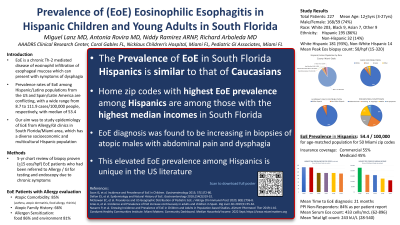Back


Poster Session D - Tuesday Morning
Category: Esophagus
D0198 - Prevalence of Eosinophilic Esophagitis in Hispanic Children and Young Adults in South Florida
Tuesday, October 25, 2022
10:00 AM – 12:00 PM ET
Location: Crown Ballroom

Has Audio

Miguel Lanz, MD
AAADRS Allergy and Asthma Clinical Research Center
Miami, FL
Presenting Author(s)
Miguel Lanz, MD1, Antonia Rovira, MD2, Niddy Ramirez, ARNP1, Richard Arboleda, MD3
1AAADRS Allergy and Asthma Clinical Research Center, Miami, FL; 2Nicklaus Children's Hospital, Miami, FL; 3Pediatric Gastroenterology Associates (PEDGA), Miami, FL
Introduction: Eosinophilic Esophagitis (EoE) is a chronic allergic/immune Th-2 mediated disease of eosinophil dysfunction/infiltration of the esophageal mucosa which is increasing in developed countries. With advances in treatments for EoE, it is paramount to study characteristics of EoE in varying populations. Studies on the incidence/prevalence of EoE in Spain, Latin America, and US populations have shown conflicting results in minorities with EoE, and there are no studies of the Hispanic population specific to South Florida. Our study aims to evaluate the epidemiology of EoE presenting to specialty clinics in metropolitan Miami area.
Methods: We conducted a 5-year chart review from Pediatric GI and Allergy/Immunology clinics in Miami, FL for biopsy-proven EoE patients. All patients had esophageal biopsies with > 15 eos/hpf. Patients were referred for GI endoscopy and/or Allergy evaluation for EoE. Patients were identified by ICD-10 diagnosis code (K20.0) and categorized by sex, age at diagnosis, race, ethnicity, residential zip codes, presenting symptoms, months to diagnosis, esophageal mucosal appearance, peak eosinophil biopsy count biopsy, PPI responsiveness, atopic history/comorbidities, and food/environment allergy testing.
Results: Our cross-sectional study revealed 227 EoE patients, 168 males (74%), mean 12 + 5yrs (range 3-27), 203 White (89%), 9 Black (4%), 7 Asian (3%), 9 Other (4%), and overwhelming Hispanic 195 (86%) population, consisting of 181 White Hispanic (93%) compared to 14 non-White Hispanics (7%). The prevalence of EoE in Hispanics was 54.4/100,000 in Miami-Dade County, from a pediatric population of 458,224. Even with 55% Commercial vs 45% Medicaid, 3 out of 4 highest EoE/zip code accounted for the top 3 median incomes/zip code. Mean peak eos biopsy count was 58/hpf, serum eos was 433 cells/uL, and IgE 243 kU/L. The most common presenting symptoms were abdominal pain, vomiting, and dysphagia. A majority were PPI nonresponders with atopic comorbidities.
Discussion: In South Florida, with its White-Hispanic majority, the elevated EoE prevalence from our study is unique to the US literature. Additionally, the highest EoE prevalence was found in zip codes with the highest median incomes. Our clinics found EoE to be increasing in esophageal biopsies of atopic males presenting with abdominal pain and dysphagia. With new EoE therapies treating the underlying systemic disease, epidemiologic data of diverse U.S. populations can help guide treatment decisions and lead to improved care.
Disclosures:
Miguel Lanz, MD1, Antonia Rovira, MD2, Niddy Ramirez, ARNP1, Richard Arboleda, MD3. D0198 - Prevalence of Eosinophilic Esophagitis in Hispanic Children and Young Adults in South Florida, ACG 2022 Annual Scientific Meeting Abstracts. Charlotte, NC: American College of Gastroenterology.
1AAADRS Allergy and Asthma Clinical Research Center, Miami, FL; 2Nicklaus Children's Hospital, Miami, FL; 3Pediatric Gastroenterology Associates (PEDGA), Miami, FL
Introduction: Eosinophilic Esophagitis (EoE) is a chronic allergic/immune Th-2 mediated disease of eosinophil dysfunction/infiltration of the esophageal mucosa which is increasing in developed countries. With advances in treatments for EoE, it is paramount to study characteristics of EoE in varying populations. Studies on the incidence/prevalence of EoE in Spain, Latin America, and US populations have shown conflicting results in minorities with EoE, and there are no studies of the Hispanic population specific to South Florida. Our study aims to evaluate the epidemiology of EoE presenting to specialty clinics in metropolitan Miami area.
Methods: We conducted a 5-year chart review from Pediatric GI and Allergy/Immunology clinics in Miami, FL for biopsy-proven EoE patients. All patients had esophageal biopsies with > 15 eos/hpf. Patients were referred for GI endoscopy and/or Allergy evaluation for EoE. Patients were identified by ICD-10 diagnosis code (K20.0) and categorized by sex, age at diagnosis, race, ethnicity, residential zip codes, presenting symptoms, months to diagnosis, esophageal mucosal appearance, peak eosinophil biopsy count biopsy, PPI responsiveness, atopic history/comorbidities, and food/environment allergy testing.
Results: Our cross-sectional study revealed 227 EoE patients, 168 males (74%), mean 12 + 5yrs (range 3-27), 203 White (89%), 9 Black (4%), 7 Asian (3%), 9 Other (4%), and overwhelming Hispanic 195 (86%) population, consisting of 181 White Hispanic (93%) compared to 14 non-White Hispanics (7%). The prevalence of EoE in Hispanics was 54.4/100,000 in Miami-Dade County, from a pediatric population of 458,224. Even with 55% Commercial vs 45% Medicaid, 3 out of 4 highest EoE/zip code accounted for the top 3 median incomes/zip code. Mean peak eos biopsy count was 58/hpf, serum eos was 433 cells/uL, and IgE 243 kU/L. The most common presenting symptoms were abdominal pain, vomiting, and dysphagia. A majority were PPI nonresponders with atopic comorbidities.
Discussion: In South Florida, with its White-Hispanic majority, the elevated EoE prevalence from our study is unique to the US literature. Additionally, the highest EoE prevalence was found in zip codes with the highest median incomes. Our clinics found EoE to be increasing in esophageal biopsies of atopic males presenting with abdominal pain and dysphagia. With new EoE therapies treating the underlying systemic disease, epidemiologic data of diverse U.S. populations can help guide treatment decisions and lead to improved care.
Disclosures:
Miguel Lanz: ALK – Advisory Committee/Board Member. Amgen – Speakers Bureau. AZ – Advisory Committee/Board Member, Grant/Research Support, Speakers Bureau. Optinose – Grant/Research Support. Regeneron – Advisory Committee/Board Member, Grant/Research Support, Speakers Bureau. Sanofi – Advisory Committee/Board Member, Grant/Research Support, Speakers Bureau.
Antonia Rovira indicated no relevant financial relationships.
Niddy Ramirez indicated no relevant financial relationships.
Richard Arboleda indicated no relevant financial relationships.
Miguel Lanz, MD1, Antonia Rovira, MD2, Niddy Ramirez, ARNP1, Richard Arboleda, MD3. D0198 - Prevalence of Eosinophilic Esophagitis in Hispanic Children and Young Adults in South Florida, ACG 2022 Annual Scientific Meeting Abstracts. Charlotte, NC: American College of Gastroenterology.
